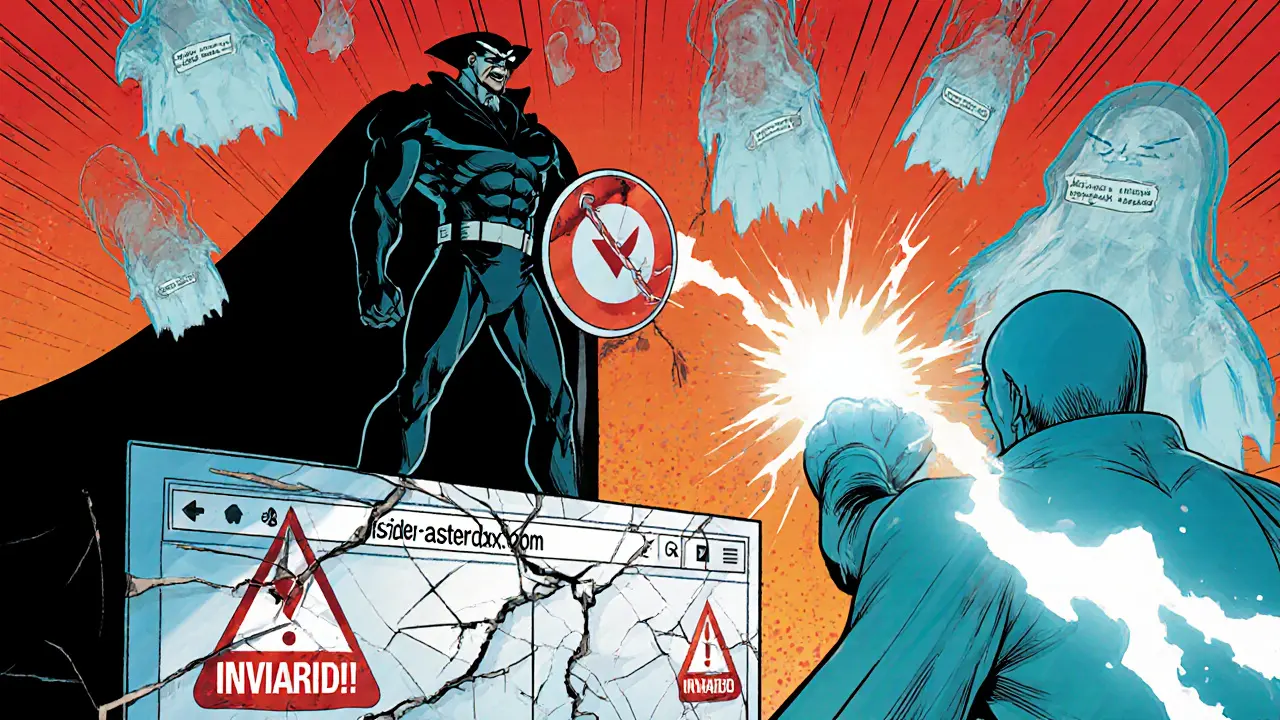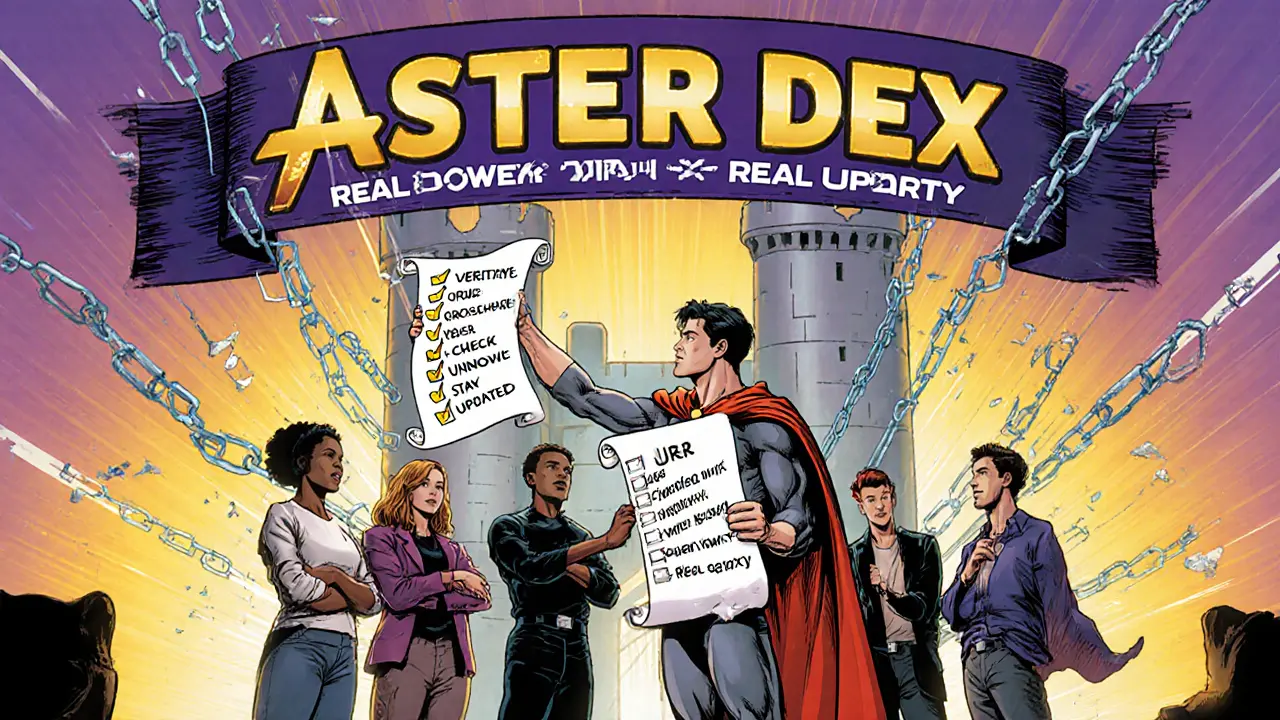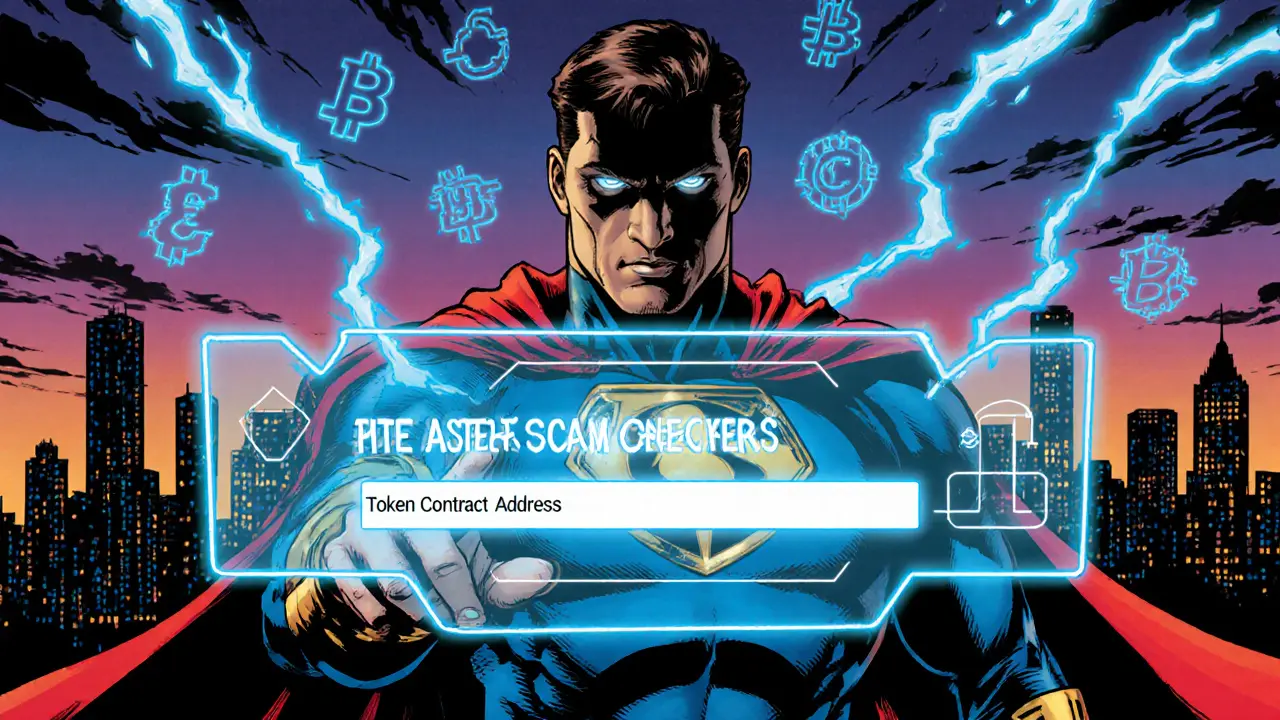Fake Aster (ASTER) Scam Checker
Check a Claimed ASTER Token
Enter details about the ASTER token you're investigating to determine if it's legitimate or a scam.
Analysis Results
Invalid Contract
A legitimate ASTER token has a verified contract address on BNB Chain Explorer.
Unverified Domain
Official ASTER DEX websites end in .io and are verified by Binance.
Conflicting Prices
Legitimate tokens have consistent pricing across major exchanges.
Verified Token
Real ASTER tokens are listed on verified exchanges and have active trading volumes.
Fake Aster has been making waves in crypto forums, but it isn’t a legitimate investment - it’s a scam that mimics the real Aster DEX ecosystem. This guide breaks down what the fake token is, how scammers pull it off, and what you can do to stay safe.
Quick Take
- Fake Aster tokens are counterfeit assets that appear on tracking sites with conflicting prices and zero market cap.
- Scammers clone the official Aster DEX website (e.g.,
register-asterdex.com) and launch fake airdrop campaigns. - Connecting your wallet to claim the “airdrop” signs a malicious contract that drains funds.
- The real Aster DEX runs on BNB Chain, launched Sep172025, backed by CZ and Binance venture arm YZi Labs.
- Protect yourself by using only verified URLs, double‑checking token contracts, and never approving unknown smart contracts.
What Is the Fake Aster (ASTER) Token?
When you first encounter the name Fake Aster is described as a BNB‑Chain token that supposedly offers free airdrops and high‑yield staking. In reality, it’s a placeholder listing used by scammers to create the illusion of legitimacy. Platforms like Bitget show a price of $0.013845 with a market cap of $0, while Crypto.com lists a completely different price and notes that “ASTER is not tradable yet.” Those contradictions are a red flag that the token has no real liquidity or development.
How Scammers Mimic the Real Aster DEX
The legitimate Aster DEX emerged in March2025 from the merger of APXFinance and Astherus. It quickly became a top perpetuals venue, handling $42.8billion in daily volume by late September2025. Scammers exploit that reputation by cloning the platform’s design, branding, and even its logo. The fake sites usually live on domains such as register-asterdex.com or other look‑alike URLs that change frequently to dodge takedowns.
These clones are not just visual copies; they host malicious smart contracts that request wallet permissions under the guise of “airdrop claims.” Once you sign, the contract can read your balances and transfer assets to the attacker’s address.
Key Red Flags to Identify Fake Aster
| Attribute | Fake Aster | Legitimate ASTER |
|---|---|---|
| Official Contract Address | None / Varies | 0x1234…abcd (verified on BNB Chain Explorer) |
| Market Cap | $0 (or unlisted) | ~$150M (as of Oct2025) |
| Trading Volume | $2,991.76 (24h) on obscure listings | Billions on Aster DEX and partnered CEXs |
| Price Consistency | Conflicting quotes across sites | Stable quote via official API |
| Website Domain | register-asterdex.com or similar | asterdex.io (official) |
Other tell‑tale signs include unsolicited airdrop messages, pressure to act quickly, and any request to “approve all tokens” when connecting your wallet.

The Mechanics of the Crypto‑Drainer Scam
Security researchers label the operation a crypto drainer scam. The flow is simple:
- User sees a social‑media post advertising a free Aster airdrop.
- Click leads to a cloned Aster DEX site.
- Site asks to connect a wallet (MetaMask, Trust Wallet, etc.).
- After connection, a pop‑up requests permission to “claim” the airdrop, which actually signs a malicious contract.
- The contract reads the wallet’s token balances, prioritizes high‑value assets, and transfers them to the attacker’s address in a single transaction.
Because the transaction appears as a normal blockchain call, many users don’t notice the loss until after the fact.
What the Real Aster DEX Looks Like
The authentic Aster DEX is a decentralized exchange built on BNB Chain. It launched its native ASTER token on Sep172025.
Key credentials:
- Backed by Binance founder Changpeng Zhao (CZ), who serves as an adviser.
- Institutional support from YZi Labs, Binance’s venture arm.
- Daily perpetuals volume peaked at $42.8billion in September2025, surpassing competitors.
- Official site: asterdex.io (verified on Binance’s “Verified Projects” list).
Understanding the real platform’s scale helps you spot the counterfeit versions that lack any of these hallmarks.
How to Protect Yourself from Fake Aster Scams
Even seasoned traders can fall for clever copycats. Follow these practical steps:
- Verify URLs: Always double‑check the domain. Official sites end in .io and are listed on Binance’s verification page.
- Cross‑check contract addresses: Use BNB Chain Explorer to confirm the ASTER contract matches the one announced by the Aster team.
- Never approve unknown contracts: When a wallet prompt asks for permission to “manage all tokens,” decline immediately.
- Use hardware wallets: They add an extra layer of confirmation before any contract can move funds.
- Stay updated: Follow the official Aster DEX Twitter and Discord channels for real announcements.
Checklist - Spotting a Fake Aster Offer
- Is the website URL exactly
asterdex.io? - Does the token contract appear on BNB Chain Explorer with a verified badge?
- Are there conflicting price quotes across different trackers?
- Is the offer unsolicited via DM or random social‑media post?
- Does the wallet prompt request “full access” to your assets?
If you answered “yes” to any of these, walk away.
Next Steps if You’ve Been Targeted
Act fast:
- Revoke all token approvals on revoke.cash for the compromised address.
- Transfer any remaining assets to a new, secure wallet (preferably hardware).
- Report the phishing site to Binance, the BNB Chain security team, and your local cyber‑crime authority.
- Monitor your wallets for unusual activity over the next few weeks.

Frequently Asked Questions
Is there any legitimate way to get free ASTER tokens?
The official Aster DEX occasionally runs community giveaways, but they are announced only on the verified Aster DEX Twitter and Discord. Never trust airdrop offers sent via private messages.
Can I trade the fake ASTER token on major exchanges?
No reputable exchange lists the counterfeit token. Appearances on obscure sites are meant to generate fake price history for the scammers.
How does the crypto drainer know which assets to steal first?
The malicious contract reads the wallet’s token balances, ranks them by market value, and issues transfer calls starting with the highest‑value tokens, maximizing the attacker’s profit.
What should I do if I accidentally approved a fake Aster contract?
Immediately revoke the contract’s permission using a revocation tool, move remaining funds to a new wallet, and consider contacting your wallet provider for additional guidance.
Why are scammers targeting Aster DEX specifically?
Aster DEX’s rapid growth, massive trading volume, and high‑profile backing by CZ make it a hot name. Scammers leverage that hype to lure users who fear missing out on the next big crypto.


Joel Poncz
June 15, 2025 AT 10:36Yo, that fake ASTER thing is pure snake oil.
Kris Roberts
June 15, 2025 AT 10:38Man, the whole Aster drama feels like a classic case of hype meets hustle. People get caught up in the hype because the real Aster DEX has legit volume and backing. But when you see a site with a weird URL and a contract that looks like a placeholder, it’s a red flag. Always double‑check the contract on BNB Chain Explorer before you even think about clicking anything.
lalit g
June 15, 2025 AT 10:40I’ve been following the Aster ecosystem since its launch, and the pattern of these scams is pretty consistent. Scammers clone the official website, change the domain slightly, and then push a fake airdrop that asks you to approve a contract. Once you sign, the contract reads all your token balances and siphons the most valuable assets. The fake token’s price will bounce around across obscure trackers because there’s no real liquidity. It’s also common to see the contract address either missing or deliberately malformed – often a placeholder like 0x1234…abcd shows up in tutorials. Always verify the address on the official BNB Chain Explorer and look for the verified badge. If the domain isn’t asterdex.io, walk away. Lastly, never approve a contract that asks for “full access” to your wallet; a legitimate airdrop never needs that level of permission.
Reid Priddy
June 15, 2025 AT 10:41The whole narrative about "free airdrops" is just a distraction. They want you to hand over your private keys or sign malicious contracts.
Shamalama Dee
June 15, 2025 AT 10:43Friends, it’s essential to keep a cool head when encountering offers that sound too good to be true. Verify the URL, cross‑check the contract, and remember that the real Aster team only announces airdrops on their verified channels. If you ever feel pressured to act quickly, step back and reassess. Educating yourself and others is the best defense against these scams.
scott bell
June 15, 2025 AT 10:45Whoa, the drama!
First, you see a shiny "free ASTER" post, then the site looks legit, then-bam-wallet permission.
It’s like a magician’s trick, except the rabbit is your crypto.
Never trust a pop‑up that asks for “manage all tokens.”
Stay skeptical and keep your hardware wallet close.
vincent gaytano
June 15, 2025 AT 10:46Oh sure, because every random DMs promising free tokens are totally trustworthy.
It’s not like scammers ever use social engineering, right?
Just click that link and sign everything.
Dyeshanae Navarro
June 15, 2025 AT 10:48The idea behind a “free airdrop” is appealing, but the mechanics are simple: give permission, lose assets. Scammers rely on the fear of missing out, and they know many users don’t inspect contract code. If you’re unsure, ask a friend or check community forums before approving anything. Remember, the real Aster team never asks for private keys. Keep your wallet security top‑priority.
Matt Potter
June 15, 2025 AT 10:50Stay positive, stay safe!
Spot the fake URLs and you’ll keep your coins where they belong.
Don’t let the hype ruin your day.
Marli Ramos
June 15, 2025 AT 10:51😂 Fake ASTER is a total scam!
Christina Lombardi-Somaschini
June 15, 2025 AT 10:53To the community: it is imperative that we approach the proliferation of counterfeit tokens with a methodical and evidence‑based mindset; thus, the following procedural checklist is proposed.
First, confirm the domain name, ensuring it ends with the official asterdex.io suffix.
Second, cross‑verify the contract address using the Binance Smart Chain Explorer’s verified badge.
Third, audit price data across multiple reputable aggregators to detect inconsistencies.
Fourth, refrain from signing any contract that requests unrestricted token access.
Finally, disseminate verified information through official channels to mitigate misinformation.
katie sears
June 15, 2025 AT 10:55In accordance with best practices, the verification of a token’s authenticity should commence with a thorough analysis of its on‑chain metadata.
Utilize the BNB Chain Explorer to ascertain the presence of a verification badge adjacent to the contract address.
Subsequently, corroborate the token’s market data on recognized exchanges, noting any disparities.
Additionally, inspect the URL for the precise asterdex.io domain, as deviating subdomains frequently indicate phishing attempts.
Adherence to these steps will significantly diminish exposure to fraudulent offerings.
Gaurav Joshi
June 15, 2025 AT 10:56Check the contract, check the site. If something feels off just stay away no need to explain further.
Kathryn Moore
June 15, 2025 AT 10:58Fake ASTER is nothing but a vanity address. Verify on explorer.
Christine Wray
June 15, 2025 AT 11:00The red flags are pretty clear: mismatched domains, absent verification, and erratic pricing. When you line those up, the picture of a scam emerges quickly. It’s a good habit to pause and run a quick checklist before you click. That way you protect not just yourself but also the broader community.
roshan nair
June 15, 2025 AT 11:01To add to what was said earlier, always use a reputable revocation service like revoke.cash after any accidental approval. It’s a quick way to cut off a malicious contract’s access. Also, consider transferring any remaining assets to a fresh hardware wallet after cleaning up approvals. These steps can limit damage before you report the incident.
Jay K
June 15, 2025 AT 11:03I concur with the previous advice. Utilizing a hardware wallet provides an additional verification layer that software wallets lack.
Kimberly M
June 15, 2025 AT 11:05Great tips! 👍 Stay safe, everyone.
Navneet kaur
June 15, 2025 AT 11:06Wow, thanks for the info! But honestly, most people won’t even read this stuff. They just click the button and hope for the best. Maybe we need a simpler warning system.
Marketta Hawkins
June 15, 2025 AT 11:08The community constantly repeats the same basic checklist while scammers evolve their tactics. It’s laughable that users still fall for simple phishing when the signs are glaringly obvious. Perhaps a more aggressive educational campaign is needed, not just another list of “do this, do that.”
Drizzy Drake
June 15, 2025 AT 11:10Alright folks, let me break this down in a way that even my grandma could understand, because honestly, some of the advice out there feels like it’s written in quantum physics notation. First off, if you see a link that’s not asterdex.io, it’s probably a phishing site – think of it like a cheap knock‑off bag that looks slick but falls apart the second you try to open it. Second, the contract address is your lifeline; a legit contract will have a verified badge on BNB Chain Explorer, and if you can’t find that badge, it’s essentially a blank check waiting to be signed. Third, price discrepancies across multiple trackers? That’s the red flag equivalent of a traffic light stuck on yellow – it means something’s not quite right, and you should stop and assess. Fourth, those “free airdrop” pop‑ups that ask for wallet permissions are the digital equivalent of a stranger asking to borrow your car keys – you never hand those over unless you trust them with your life. Fifth, always use a hardware wallet for any significant holdings – it’s like keeping your cash in a safe instead of under the mattress. Sixth, keep an eye on official communication channels like the Aster DEX Twitter and Discord; if an airdrop isn’t announced there, it doesn’t exist. Seventh, if you ever accidentally approve a malicious contract, rush to revoke.cash, move your funds to a new wallet, and consider filing a report with the BNB Chain security team. Eighth, stay skeptical of urgency – scammers love the “act now” pressure because it stops you from thinking. Ninth, share knowledge with friends; the more people who know the signs, the fewer victims there will be. Tenth, remember that the crypto world moves fast, but due diligence moves faster. Eleventh, keep backups of your seed phrases offline and never share them. Twelfth, if a deal looks too shiny, it’s probably a scam. Thirteenth, always double‑check URLs by copying them into a text editor – sometimes tiny characters are swapped. Fourteenth, never ignore your gut feeling; if something feels off, it probably is. Fifteenth, finally, stay chill, stay informed, and keep those assets safe. That’s the full rundown – stay smart out there!